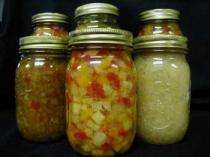Home canning on the rise again, but do it safely, expert warns

Sometimes old ideas are the best ideas, and certainly home canning is one of those. But despite generations of practice, many don't do it properly, warns a food-safety expert in Penn State's College of Agricultural Sciences.
There is no better way to capture a garden's bountiful harvest to use throughout the year than home canning, according to Martin Bucknavage, senior extension associate in food science. And with the tough economy, home canning seems to be on the rise, with people "putting up" jars of vegetables such as tomatoes, green beans, peppers and pickles.
"But after talking with many home preservers over the past year -- both those new to canning as well as those who have been processing for a long time -- we have found that many are doing it incorrectly," he said. "Some folks are not using approved processes, while others are not using the proper equipment."
Bucknavage urged special caution when preserving nonacidic foods, also known as low-acid foods, because a pressure canner must be used. Foods such as meats, green beans and corn must be exposed to the high temperatures that are only possible under pressure. If insufficient temperatures are used in processing, it is possible for spores of Clostridium botulinum to survive and then grow in the products when cooled.
"The causative agent of botulism, Clostridium spores are found throughout the environment -- including in garden soil -- and once in these canned foods, they produce an extremely potent toxin that often results in death," he said. "There are always people who will claim that they don't need a pressure canner because their mom or grandma never used one. But these people were lucky.
"It is just not worth the risk of canning these low-acid foods without a pressure canner."
Another risky practice people still employ is canning in their oven, Bucknavage noted. This method is dangerous because it is difficult to generate the proper temperatures needed, and the packaging can be damaged during the process. "Both issues can lead to premature spoilage, the growth of pathogenic microorganisms, or even broken glass jars that can cut you," he said.
Follow scientifically developed canning processes and formulations, Bucknavage advised. He recommended the following: "The Complete Guide to Home Canning and Preserving" (USDA, 2008); "So Easy to Preserve" (University of Georgia, 2006); "Complete Book of Home Preserving" (Ball, 2006); and the "Let's Preserve" series available through Penn State Cooperative Extension.
"All process times in those sources are scientifically validated to ensure safety," he said. "These books are inexpensive and are a valuable resource for the home canner. If your canning book was your grandmother's or your great grandmother's, it is time for a new book.
"Our understanding of the science of canning has improved, and the processes in these modern books reflect that understanding."
Some home canners insist it is possible to safely deviate from the given formulations, but Bucknavage advises against taking such license. "Even small changes in the recipe can change the heating characteristics of the product," he explained. "The times and temperatures are dependent upon how easily heat can get to the 'cold point' of the container. If this heating dynamic is changed, the product may not receive enough heat."
Bucknavage suggested contacting your local Cooperative Extension office if you have questions about home canning.















